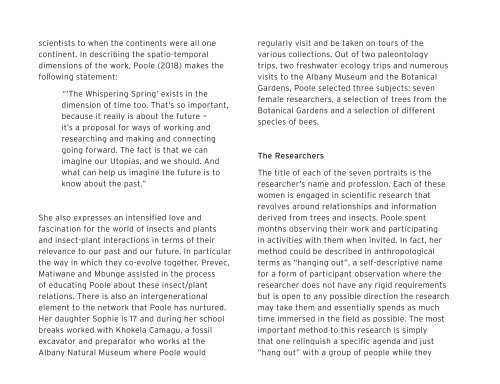Tanya Poole, The Whispering Spring
Tanya Poole's solo exhibition 'The Whispering Spring'. Galerie M Bochum. 07.12.18 - 27.04.19. https://m-bochum.com/press_en.php?SID=XW6pvHsUTM53&eid=174
Tanya Poole's solo exhibition 'The Whispering Spring'.
Galerie M Bochum.
07.12.18 - 27.04.19.
https://m-bochum.com/press_en.php?SID=XW6pvHsUTM53&eid=174
Create successful ePaper yourself
Turn your PDF publications into a flip-book with our unique Google optimized e-Paper software.
scientists to when the continents were all one<br />
continent. In describing the spatio-temporal<br />
dimensions of the work, <strong>Poole</strong> (2018) makes the<br />
following statement:<br />
“‘<strong>The</strong> <strong>Whispering</strong> <strong>Spring</strong>’ exists in the<br />
dimension of time too. That’s so important,<br />
because it really is about the future —<br />
it’s a proposal for ways of working and<br />
researching and making and connecting<br />
going forward. <strong>The</strong> fact is that we can<br />
imagine our Utopias, and we should. And<br />
what can help us imagine the future is to<br />
know about the past.”<br />
She also expresses an intensified love and<br />
fascination for the world of insects and plants<br />
and insect-plant interactions in terms of their<br />
relevance to our past and our future. In particular<br />
the way in which they co-evolve together. Prevec,<br />
Matiwane and Mbunge assisted in the process<br />
of educating <strong>Poole</strong> about these insect/plant<br />
relations. <strong>The</strong>re is also an intergenerational<br />
element to the network that <strong>Poole</strong> has nurtured.<br />
Her daughter Sophie is 17 and during her school<br />
breaks worked with Khokela Camagu, a fossil<br />
excavator and preparator who works at the<br />
Albany Natural Museum where <strong>Poole</strong> would<br />
regularly visit and be taken on tours of the<br />
various collections. Out of two paleontology<br />
trips, two freshwater ecology trips and numerous<br />
visits to the Albany Museum and the Botanical<br />
Gardens, <strong>Poole</strong> selected three subjects: seven<br />
female researchers, a selection of trees from the<br />
Botanical Gardens and a selection of different<br />
species of bees.<br />
<strong>The</strong> Researchers<br />
<strong>The</strong> title of each of the seven portraits is the<br />
researcher’s name and profession. Each of these<br />
women is engaged in scientific research that<br />
revolves around relationships and information<br />
derived from trees and insects. <strong>Poole</strong> spent<br />
months observing their work and participating<br />
in activities with them when invited. In fact, her<br />
method could be described in anthropological<br />
terms as “hanging out”, a self-descriptive name<br />
for a form of participant observation where the<br />
researcher does not have any rigid requirements<br />
but is open to any possible direction the research<br />
may take them and essentially spends as much<br />
time immersed in the field as possible. <strong>The</strong> most<br />
important method to this research is simply<br />
that one relinquish a specific agenda and just<br />
“hang out” with a group of people while they



